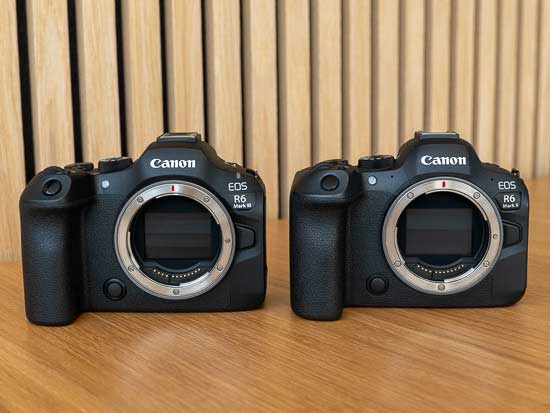
Three years is a long time in the world of photography, so Canon have finally updated the popular EOS R6 camera for 2025 with the launch of the Mark III version. But what exactly has changed since the R6II, is it really worth upgrading and ultimately which one should you buy?
Although they look exactly the same, the new R6 III and older R6 II differ somewhat when it comes to their specifications and features, so much so that cash-conscious buyers may be wondering if the older model still offers everything that they need, or whether the newer Mark III has a few clever tricks up its sleeve that are worth the upgrade.
So we’re bringing you this in-depth Canon EOS R6 Mark III vs Canon EOS R6 Mark II head-to-head comparison to help you choose between these two mid-range full-frame mirrorless cameras.
You can also read our detailed Canon EOS R6 Mark III review and Canon EOS R6 Mark II review to find out exactly what we think of both cameras.
Sensor
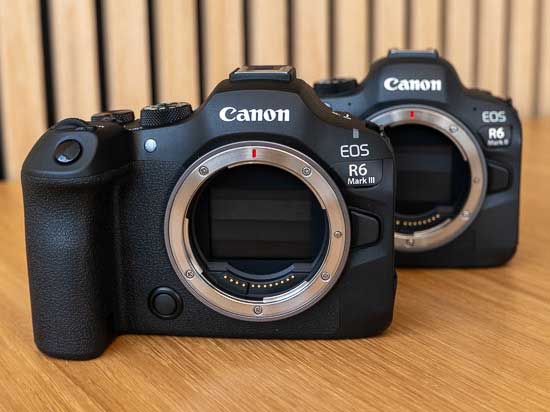
The older EOS R6 Mark II has a 24.2 megapixel CMOS sensor.
One of our concerns with the sensor inside the Canon R6 II is whether or not it was of high enough resolution for its general enthusiast target market, especially if you like to heavily crop your images in post-production.
The R6 III utilises a new 32.5 megapixel CMOS sensor which provides a 25% increase in resolution compared to its 24.2 megapixel predecessor, as well as offering 7K 60p internal RAW video recording.
Processor
Both models benefit from using the latest Digic X processor.
ISO Speed
On the R6 II, the ISO range runs from 100-102,400, which can be further expanded up to ISO 204,800 and down to ISO 50.
Due to the resolution increase, the native ISO range on the Mark III R6 runs from 100-51,200, which can be expanded up to ISO 102,400 and down to ISO 50
Video
The Canon EOS R6 II can record 4K video up to 60p in 10-bit, achieved through oversampling from 6K. It also offers 6K/60p ProRes Raw recording, but only externally via HDMI rather than internally. plus 1080p slow-motion recording up to 180fps.
The Mark II R6 also offers several other video features like focus breathing correction, a false colour exposure aid, a 3/5 second pre-recording function, CLog3 profile, and a quick control screen just for video.
The newer R6 III supports internal RAW video recording at up to 7K 60P or 7K/30p with Open Gate turned on, high frame rate recording at up to 4K 120P / 2K 180P, oversampled 4K/60p and also 4K/60p UVC live streaming for the first time ever on a full-frame EOS camera.
Other video-centric features include waveform monitor, proxies, metadata tagging, a full size HDMI port, 4 channel audio, 3/5 sec pre-recording function, 15+ dynamic range and CLog 2 and 3 profiles.
Autofocus
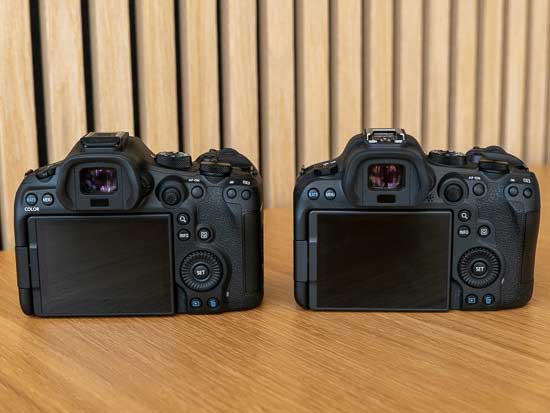
The R6 II has a very similar auto-focus system to the flagship EOS R3 sports camera, with AI tracking that can recognise humans, dogs, cats, birds, horses, aircraft and trains.
The new model uses the same AF system but offers improved tracking algorithms and also introduces a few new features.
The Registered People Priority mode can detect and prioritise up to 10 faces even in side profile, useful for sports, news and weddings, with the ability to save 10 files on a memory card each with 10 registered faces.
Just like on the R5 II and R1, you can recall AF settings on the Canon R6 III by registering up to six custom AF setting profiles to save time on pre-shooting setting configuration.
Both cameras can focus in light levels as low as -6.5EV (when used with an F1.2 lens).
Burst Shooting

Both models can still shoot at 12fps with the mechanical shutter and 40fps with the electronic shutter, thereby offering the fastest burst shooting in their class.
The buffer is bigger on the R6 III though (when using CFexpress cards) – 150 versus 75 uncompressed RAW files – and pre-continuous shooting up to 20 frames (Raw or JPEG/HEIF) is available before fully pressing the shutter button.
Both cameras offer a maximum shutter speed of 1/16,000th second when using the silent electronic shutter.
Body and Design
The 2025 version is almost exactly the same size and weight as the previous EOS R6 Mark II and has an almost identical design.
It is identical in size to the Mark II but slightly heavier, weighing in at 699g with battery and memory card or 609g body only.
IBIS
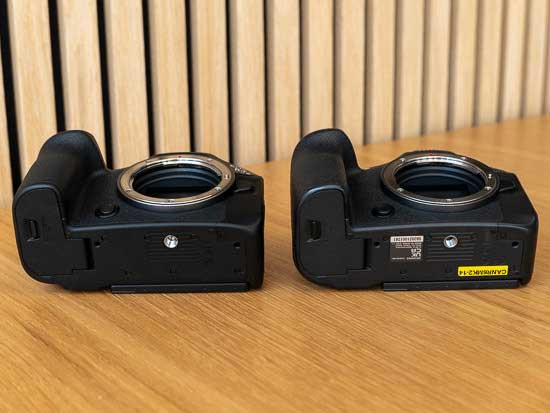
The R6 II’s intelligent stabilisation system provided an incredible 8-stops of stabilisation with some lenses, allowing you to hand-hold the camera for up to 4 seconds and still get critically sharp results.
The Mark III is ever so slightly better, now offering up to 8.5-stops of image stabilisation available via a combination of the camera’s in-body Image Stabiliser which works in tandem with the attached lens’s own stabilisation system.
Viewfinder
Both the Canon R6 II and R6 III have the same 0.5inch 3.69 million dot electronic viewfinder (EVF) that operates up to 120fps for minimal lag when shooting fast-moving subjects.
It incorporates a special OVF simulation mode, similar to the one of the EOS R3, which uses HDR technology to simulate a more “real-world” view of the scene.
LCD Screen
Both cameras use the same 3-inch, 1.62 million dot, vari-angle LCD screen which tilts out to the side and faces forwards for more convenient vlogging and selfies.
Memory Cards
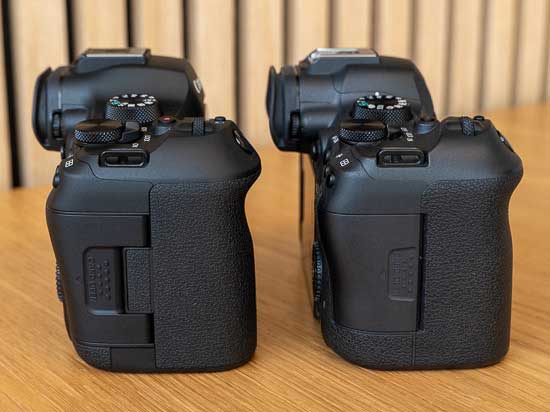
The R6 II supports two SD UHS II cards via dual slots, with the ability to record to both cards simultaneously.
The newer Mark III model now employs dual CFexpress and SD card slots in order to support the faster video frame rates.
Battery Life
The R6 Mark II uses the same LP-E6NH battery as the original R6, whereas the R6 III employs the LP-E6P battery from the EOS R5 II.
This provides 620 shots according to CIPA standards versus 450 shots on the R6 II.
Connectivity
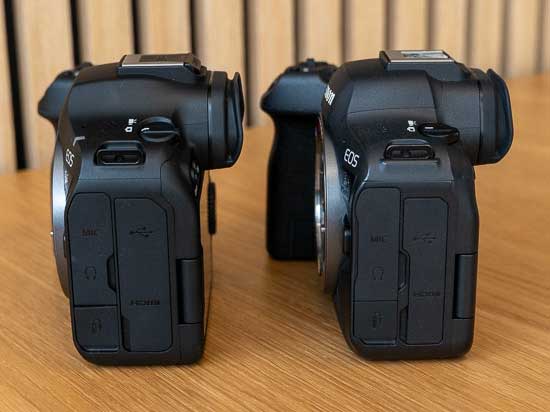
The R6 II supports both 2.4GHz and 5GHz wi-fi, Bluetooth 5.0 and offers the ability to operate as a webcam or use the camera for 1080p live streaming via UVC/UAC.
The Mark III R6 features 5GHz wi-fi and Bluetooth 5.1 support, the ability to operate as a webcam and also 4K/60p UVC live streaming for the first time ever on a full-frame EOS camera.
Price
On launch, the Canon EOS R6 Mark III is priced at £2799.99 / €3199.99 body only in the UK and Europe respectively.
The EOS R6 II was priced at £2779.99 / €3149.99 / $2499.00 in the UK, Europe and US respectively when it launched in 2022, so commendably the price hasn’t risen by very much at all.
Conclusion
The Canon EOS R6 Mark III is another solid upgrade of an already excellent camera, principally improving the image stabilisation, buffer size and battery life along with offering 25% more resolution, more capable video, dual CFexpress and SD card slots and improved connectivity.
So what do you think? Would you choose the new Canon EOS R6 Mark III or its still very capable predecessor (which remains on sale through-out 2026)? Leave a comment below!
Your Comments
Credit : Source Post

